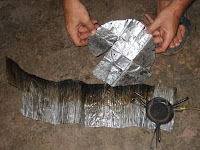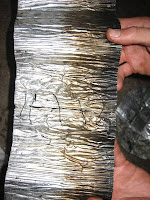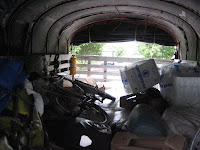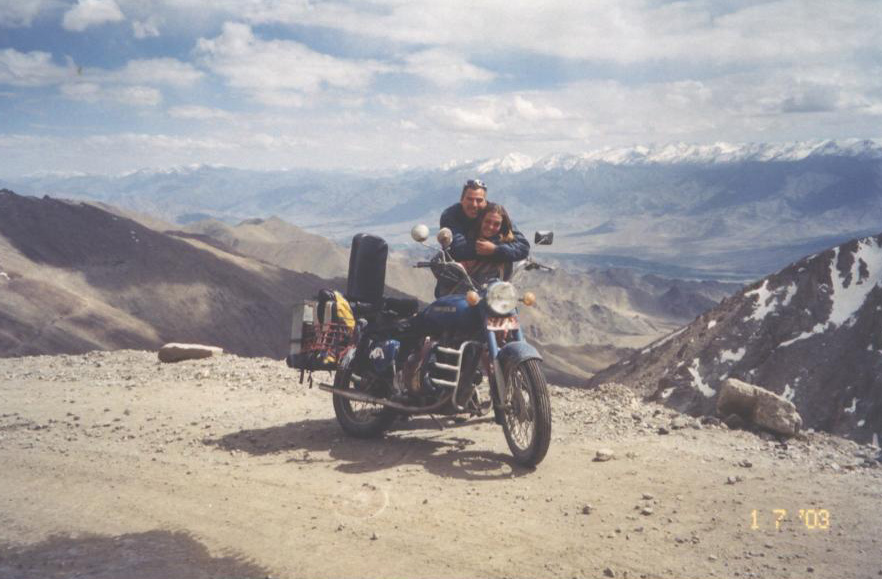We found ourselves on the sea front, stumbling towards the old city, like drunks or people who have been a week at sea, in search of a hotel. Gal had a terrible headache.
We were thrilled by the amount of street food and enjoyed the famous
After checking more than 10 hotels in the cheep and notorious Getsmani neighborhood, near the old quarter, we compromised on the “best of the worst”, an overpriced small, simple room (toilets outside). Exhausted, we went back to the port, to get our stuff.
Leo, our captain, gently rowed the dinghy with our luggage + bikes, and gave us our passports. We immediately noticed we got a 30 day visa, which was exactly 30 days too short. We made some grumpy noises and left, not before talking about “a tomar algo” (to drink something), a phrase which will be used often.
Despite Gals’ headache, we did the mature thing, went to a car wash and washed the salt off our bike. The car wash people didn’t want any money – welcome to
Exhausted, we cycled to our hotel to rest.
We spent 2 more days in this truly beautiful colonial town, strolling in the afternoon in the narrow streets, between the old buildings with their elegant wooden balconies, watching the sunset, and enjoying the breeze from the massive defensive wall, overlooking the Caribbean Sea, everything well restored; one could almost imagine the pirates…
Only once we made the mistake of attacking town at noon time and understood the reason for the siesta: the heat was unbearable and we couldn’t find any shaded place.
We had a few beers with Leo and Angela at the “Donde Fidel”, in the main square, and later Angela took us to see one of her favorites Salsa joints, a place fool of style.
In our hotel we encountered the masses of backpackers, more than 50% Israelis. Chitchatting with them we learned the 2 main reasons for hanging around
Gal used the time to recuperate from the tough voyage (for some it is), while Rami was restless, disappointed of the average traveler (95% of them), who visits 5 out of 7 tourist attractions, part of them of no interest. 12 years ago, when Rami traveled
Visa Problems - part III 30/07/08
After Central Asia’s visa problems, our
Frustrated from our 30 days visa, we went to the DAS office, and begged the officials to change the visa to a 60/90 days, but, “computer says no!”. As if to spread salt in our wounds, we were told that if we would have arrived yesterday, on the day the visa was issued, it would have been done in 5 minutes, free of charge!
Now, we’ll need to wait till the last few days of the visa and only then extend it, in one of the DAS offices, in any province capital. Planning ahead – a new headache!
Oh, and an additional $40 per person.
 Iguanas in the main plaza.
Iguanas in the main plaza.Cycling in
We set off to our first cycling day in
The road followed the coast line, a much drier landscape than what we got used to, in tropical
In the late afternoon the road left the beach, and entered farmlands. Every 500m or so we passed someone, holding his bag of eggs (chicken eggs) for sale; many eggs!
We started searching for a camp spot, in this unfamiliar territory (a new country/continent, different culture). We learned a new word/concept: “patron”. In the first 2 fincas the patron was not there (obviously, the owner wasn’t there), and the simple workers didn’t want to take responsibility and invite us. This social system, with its castas (a small
Instead on working on our camp & dinner, we were invited to sit with the family in the garden (during mosquito time) and chat. It was different we liked it.
 Leaving Cartagena.
Leaving Cartagena.South America - day 1.



 Our first hosts in Colombia.
Our first hosts in Colombia.Dangerous
We were forced to spend the night in
Many people warned us of
We finally found a whorehouse which doubled as a cheep hotel. The rates were 6,000 Peso per hour and 22,000 for the night. The room was fine, with a TV (only local channels and 2 porno channels), a small discrete window for room service and every now and then a young girl with humungous silicon tits entering the lobby.
It was late afternoon when we attacked the city. The young, cute hotel worker warned us: “come back before 20:30”. Quite quickly the sun set and all the streets became dark and scary.
Every second street was a small river which we needed to cross. It was dripping lightly when we entered the city – how bad can the draining be? On the following day we saw in the papers pictures of cars dragged by a half meter river. Believe us it wasn’t raining!
All of a sudden walking in this neglected area, we found ourselves in front of a big, white mall. We entered, escaping from the city, in search of a breath of air. The mall was just like any mall around the world. What a outside!
It was time to go “home”. We asked for directions, but people couldn’t face the fact that our hotel is on 44’ & 44’ (it was actually 43’ & 44’, but we weren’t sure about the calle/carrera). Finally, we got it, 10 blocks that-a-way. The streets were so dark; we couldn’t read the street names/numbers. It was almost 20:30 and Gal was scared. Rami insisted on walking, we crossed a small ‘river’ and made it, just in time for curfew.
The next morning we were off early. The center was a bit messy, due to the floods. It took us more than an hour to exit. On the way we were frequently warned about this and that street (even main streets) and were directed to others.
We finally crossed the huge bridge over the Magdalena and left the most dangerous city in
 Barranquilla, from the bridge over the Magdalena.
Barranquilla, from the bridge over the Magdalena.Happy birthday to Rami 03/8/08
We reached the Peaje (tollgate of the toll road), indicating the end of the swamp land, after50km without NOTHING!
We rested at the tollgate station for half an hour, hiding from the heat, chatting with the guys and drinking about 10 liters of water. They warned us not to stop or slow down in the next 10km – it’s dangerous, poor area. Passing there, every second house had a small stall, selling shrimps in mayonnaise and terrible ketchup.
We didn’t get robbed and reached the next village. Its’ Sunday market was big and messy. We haven’t seen a ‘real’ market since Granada (Nicaragua), a month and a half ago! We needed to buy food for diner and the timing was perfect: not too early (not to carry it all day and discover that the heat killed the vegetables, even worse - meat and cheese), but still giving us time to find a camp spot (hopefully, on the beach).
We were also looking for new flip-flops. The pair we had tore 3 days ago, but we still manage to use them for the shower; it’s not an easy task to find a pair, size 44.5. Carrying another pair, the weight, we chose not to. Lucky we have the same shoe size! We found a pair, in light blue. Happy Birthday to Rami!

 Swamp lands.
Swamp lands. Dry Caribbeans.
Dry Caribbeans. Good people on the way.
Good people on the way.The birthday party was not over yet. After opening the present, we still needed a place to sleep. Rami wanted to sleep near the beach. We didn’t want to enter Santa Marta, 30km away, at night, but there wasn’t anything or there were expensive houses on the beach. We asked a house if we can camp, frustrated, and we were invited to camp under the huge palapa, just on the cliff.
Another perfect location! And with all the facilities Rami learned to appreciate: a roof, light, flat concrete floor and an outdoor shower – what more can one ask for his birthday?

 Sunset from our camp spot.
Sunset from our camp spot.
 Sunrise.
Sunrise. Ramis' cycling shirt, dead.
Ramis' cycling shirt, dead.We needed a rest day. We’ll soon leave the beaches and probably not go to the famous Park Tayrona (a hassle with the bikes and too many tourists), so we tried Santa Marta. We took the coastal road, through El Rodadero, “the best beach in Santa Marta area”, the locals told us. It was a holiday beach, with too many huge hotels on the beach, and behind, the main avenue with bars, restaurants and cheap hotels; definitely not our taste.
We reached the old center of Santa Marta, which could have been nice, but the Colombian sewage failed again, and we had to flee. We continued to the bay of Taganga, passing through the harbor and extremely poor neighborhoods.
We’ve been hearing stories about millions of trucks, carrying carbon, on the coastal road from the east (Riohacha). Our other option was the main road, south, to Bogota. In the harbor entrance we saw millions of carbon trucks and people shoving carbon. They told us that both roads are congested. We decided to take the coastal road.

 The valley of Santa Marta.
The valley of Santa Marta. חוף דבוש - Taganga 04/08/08
We crossed a hill, reviling the cute little bay of Taganga. We quickly cycled down and reached the beach. From this angle it was not as cute. Half the bay was bathing and the other half for fishing boats and taxi boats, which polluted the closed bay. The small beach was commercialized: hotels, diving clubs and the rest of the usual scene. It was probably a charming fishing village 10-15 years ago…
We found a room 30 meters from the beach and decided to rest a day, even though it wasn’t our dream beach. We went to the beach and were shocked from the tons of Israeli travelers/tourists. It immediately reminded us of a beach in Hertzelia(חוף דבוש). How can we explain, this spectacle, of arriving to a small Caribbean bay/village and seeing that 80% of the people are Israelis? Everywhere around us we heard Hebrew, so strange!
The water was pleasant, in the perfect temperature, a contrast to the Caribbean heat outside. We talked with a few of the 20 young Israelis surrounding us and one of them asked Rami if a 5-year-old kid there was his. It took Rami a few seconds to understand the question, he fell into shock, gathered himself and said: “NO!”. There is a first time for everything.
On the second evening we cooked fish with our neighbors, a young Israeli couple. We bought Barracuda and fried it, coated with corn wheat – delicious!

 Taganga bay.
Taganga bay.
Angelas’ beach 06/08/08
We passed near the Sierra Nevada de Santa Marta, the highest mountains in Colombia and the famous Park Tayrona. We were thinking of stopping at “Angelas’ finca”.
When we met Angela & Leo (from the boat to Colombia), in Cartagena, she told us about a finca of a friend/relative, near the beach, east of Park Tayrona. She told us to call her if we decide to stop there.
For us, a finca is a simple farm-house, with coconuts, bananas, chickens and cows. We sleep in fincas almost every night, choosing one near the road and continuing the next morning – simple! Now, calling someone, understanding Spanish over the phone, going who knows where, not knowing if it fits our needs, etc.
We were told to take the second left to a dirt road after “a village”. Or was it the first left? Or before? We asked for directions but were told every time: “after the curve”. It was a hilly road, everything was curves! Someone shouted to us to go left on a dirt road, and added the name that Angela told us. We cycled 3km on this dirt road, which deteriorated, crossing a creek, barefoot, and entering deep sand. The sun was already setting, mosquitoes were attacking us and we didn’t have a clue of where we’re going. Rami was grumpy!
Someone caught us and told us to follow him. We pushed the bike in the sand and reached a small paradise: in the middle of a long coconut plantation was a 2 story wooden hut, open to the wind and with a palm roof. There was a simple, perfect kitchen and shower & toilets were 20 meters behind. The patron arrived with a 20 liter drinking water container, connected the gas stove and told us to feel at home. We put all our stuff upstairs and went to the beautiful beach. It was all to ourselves. An hour later everything was totally dark. Thanks to the kerosene lamps our patron lit, we could find our way through the 100m coconut-mangrove maze.
We opened our tent under a palapa, just on the beach.
We stayed in this paradise 3 more days, eating platanos and fish. We were totally disconnected from the outside world. There wasn’t cellular coverage, so we couldn’t even SMS Rachel (Ramis’ mom) a happy birthday.
It is a long time since we had such a good vacation.
Thank you Angela!
 The Sierra Nevada de Santa Marta - Macondo.
The Sierra Nevada de Santa Marta - Macondo. Towards the finca.
Towards the finca. Just in time for sunset.
Just in time for sunset. Sunrise.
Sunrise.
 Our tent + hammock.
Our tent + hammock.



On the way to the village, to buy fish.


Shhhhhh... a snake.

Rami woke Gal up one day and asked her if she wants to see a snake, above her. While in
the tent (totally protected) she watched the snake find its' way through the roof above her.


 Fried platanos.
Fried platanos.
 Our patron.
Our patron. Buen provecho!.
Buen provecho!.

 Adios Caribbeans.
Adios Caribbeans.
 Leaving paradise.
Leaving paradise.Leaving the coast 10/08/08
We enjoyed our last day of cycling on the Caribbean, between platano and coconut plantations. We tried camping on the beach for the last time, but reached another neglected village. It didn’t have any running water for the last 13 days! This explains all the people taking a bath in the river. How come the authorities didn’t fix the aqueduct yet?
We left the village in search for a finca; it was late. We passed more than 10km with nothing till we reached a house. Turns out the house was on the river from which the people, from a nearby village, were pumping water for the last 13 days.



 The whole village athing in the river.
The whole village athing in the river.
Music in the morning.

 A typical shop.
A typical shop.
 A present - a reflective jacket.
A present - a reflective jacket.
The next night we slept in a finca with cows. We were warmly welcomed. Later, a military force came to camp in the finca and put a road block just outside, a common scene in Colombia.
 Tanks in the background.
Tanks in the background.In the following days we slept in very relaxed countryside, many cows, fresh milk and fruit shakes. People were very warm and welcoming.
 Another typical shop.
Another typical shop.
 With Yannis' family.
With Yannis' family. The eastern cordillera.
The eastern cordillera. Arepas.
Arepas. Too many funny vendors.
Too many funny vendors.

 Another nice finca.
Another nice finca.

 Look what happened to our wind stopper...
Look what happened to our wind stopper...
 Leaving the finca.
Leaving the finca.
 African palms (before).
African palms (before).
 And after.
And after.Vallenato 15/08/08
We entered Agustin Codazzi early in the morning. There was a big sign notifying about a big music festival. We decided to stop early and enjoy the small town and the festival.
The only thing special about Agustin Codazzi is the “Instituto Geográfico Agustin Codazzi”, which publishes detailed maps of Colombia. Nothing else. People were drinking from early noon, inviting us for more and more beers in this hot, sunny day; part of the festival or ”another day in the office” ?
Since we left the Ranchero music in Mexico, we’ve been waiting for the Salsa in the streets of Colombia. Turns out we were wrong! The music of Colombia, all Colombia (except Cali area and south) is Vallenato, a sort of Latin Chanson, with a bit of rhythm and a leading accordion. Usually it’s terrible, but once in a blue moon there is an O.K. song, objectively speaking.
In the main plaza of town crowded many thousands of people. Loud Vallenato music was blasting from every bar and beer stands around, making an elegant mix of songs. Fat Colombians (very, very chubby) were munching food and drinking beer. Here and there a chubby couple was wiggling their asses and turning, almost falling asleep, dancing ‘the dance’, to the music. At about 23:00, after 3 hours of boredom, the live band finally went on stage. About 20 players played drums, trumpets, trombones… you name it, for a few minutes and then, the real star arrived, dressed in fleshy club clothes, walking like a proud cock, with an accordion in his hands. The crowd was in ecstasy! Young girls were crying and shouting! The geek with the accordion was a super star! Where is the FUCKING Salsa?


The ciénaga 17/08/08
We were on the main road between Santa Marta and Bucaramanga, with millions of trucks passing us. We missed the relaxed detour we just had. We stopped for the night at the beautiful finca “La Fe”. The owner (the architect who built the house) and another couple (doctors) were our hosts. They persuaded us to ride early in the morning to the “ciénaga de zapatosa” (a big swamp created by the Magdalena river), only 15 minutes away and it’s a good dirt road. Both, Gals’ love for big rivers (the Magdalena) and our stupidity to believe these educated Colombians about distances and time, made us go. 2 minutes on the paved road and them 2.5 hours on a bad dirt road which deteriorated till we were stuck in the mud. All the way people encouraged us: “6km away” (when it was 20km), “5km away” (when it was 9km) and then “1km away” for a few more kilometers. The last 2km were mud, even swamps. Are we there already? What are we looking for? The bikes were sp clean before, but now all the gear was filled with mud and so were our shoes. Exhausted, we slowly cycled back to La Fe. Somehow, the way back is always faster…


Mud!!!
 Gal in the mud.
Gal in the mud. For this?!?
For this?!? La Fe.
La Fe.How to hitch a ride
Tiered from the ciénaga adventure, Rami insisted on hitching the last 80km of the heavy truck traffic. So, we waited near a restaurant, but nothing for more than half an hour. We asked a truck driver, who was resting at the restaurant, if we can hitch. He told us that there is a police checkpoint 3km ahead, and he will get a fine for carrying passengers in the back. He thought for a second and suggested we cycle to the checkpoint and ask the police if we can hitch from there; the traffic slows down. He will arrive and will get the police approval to carry us behind… and it worked! Rami was sleeping on bags of salt, while Gal chitchatted with him and his partner. It took us more than an hour, but we managed to enter Aguachica just before dark. Carlos, the driver, offered to take us till Ocaña, up in the mountains, where he lives. We politely refused; the reason for the detour east was to cycle in the eastern cordillera! He invited us to his house, if and when we pass through.
 Carlos at the checkpoint.
Carlos at the checkpoint. On the truck.
On the truck.We worked 3 hours on cleaning the bikes. There wasn’t a hose, which would have quickened the job (if only we had high-pressure water). The mosquitoes bit us like mad, the notorious Latin mosquitoes. The reason for doing this at night was our plan to attack tomorrows’ climb early.
Exhausted and hungry, we finally went out to the main street in a desperate search for food. All the hamburgers and perro caliente (literally - hot dog) stands, with their supply of sweet ketchup and mayonnaise were not tempting at all. We finally found a tiny, portable pizza stand (quit impressive!) with fresh pizza. We very quickly swallowed a whole tray and were ready to sleep.
Another long day!
Gal was dreaming - the Andes… tomorrow…

No comments:
Post a Comment